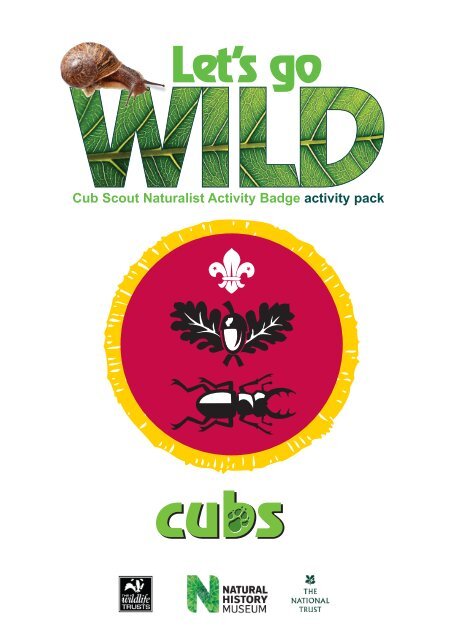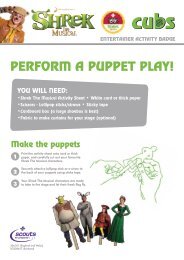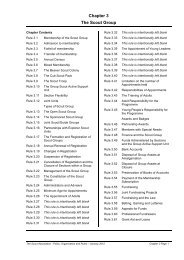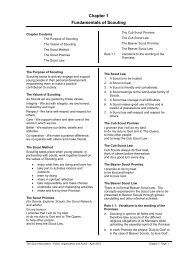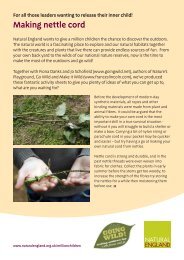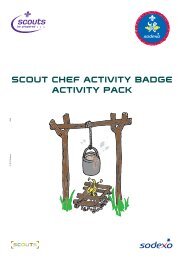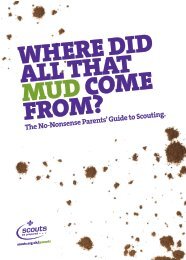Cub Scout Naturalist Badge Activity Pack
Cub Scout Naturalist Badge Activity Pack
Cub Scout Naturalist Badge Activity Pack
Create successful ePaper yourself
Turn your PDF publications into a flip-book with our unique Google optimized e-Paper software.
The <strong>Cub</strong> <strong>Scout</strong> Let’s go Wild <strong>Activity</strong> <strong>Pack</strong> | 2Welcometo your activity packWant to discover nature on your doorstep? Fancydiscovering pond life, spotting bugs or tempting birds intoyour garden? Then you’ve come to the right place.This activity pack is stuffed full of activities to help you get closeto nature. This could be in your back garden, local park, orfurther afield in wild spaces such as woods, nature reserves orthe seaside. The activities will also help you work towards your<strong>Naturalist</strong> <strong>Activity</strong> <strong>Badge</strong>.Supported by the National Trust, the Natural History Museumand The Wildlife Trusts, this pack is sure to help you make themost of the great outdoors.Ready? Then let’s go wild.
The <strong>Cub</strong> <strong>Scout</strong> Let’s go Wild <strong>Activity</strong> <strong>Pack</strong> | 43. Garden bird detectivesBecome a garden bird detective. Make a bird feederto encourage birds to visit your garden. Then spend halfan hour every day for a week recording the birds you spot.When? Autumn and winter are the best times for thisactivity when birds are more likely to suffer food shortages,but you can feed and record birds at any time of the year.4. Dipping dudesPonds and lakes are home to a fantastic range of plants andanimals, but many ponds are polluted by chemicals and litter,or have been neglected. Survey a pond or lake and find outhow healthy it is by recording what animals you find living in it.When? Spring and summer.5. Seaweed sleuthsLiving in the UK, you are never more than about 70 milesfrom the coast, and our seashores vary from rugged cliffsto sandy beaches. Explore the seashore and learn to identifysome common seaweeds.When? Any time of the year.6. Tree trackersTake a close look at the trees growing in your garden, or localstreets and parks. Learn to identify the most common onesand do a tree survey by identifying and recording the treesgrowing in your area.When? Spring and summer (when the leaves are on thetrees) are best because the trees are easier to identify.
<strong>Activity</strong> 1.How to become a hedgerow houndHedges are found all over our towns and countryside, from ourgardens and parks to field boundaries. Many are hundredsof years old and consist of old trees and shrubs which providefood and shelter for a wide range of animals and other plants.Take a close look at a hedge in your local area and record thewildlife you spot.When? Any time of the year.You don’t need any special equipment to find out what’s living inyour local hedge but if you want to add your results to anationwide survey you need to fill in an OPAL BiodiversitySurvey Workbook (ask your leader to download it and print outthe recording forms on pages 5 and 6).Hedge findsThe <strong>Cub</strong> <strong>Scout</strong> Let’s go Wild <strong>Activity</strong> <strong>Pack</strong> | 51. Choose a three-metre section of hedge to explore.Make a note of where the hedge is, and whether it is madeup of bushes, trees or both. Record how well looked after itis, whether there are any gaps in it and the approximateheight and width of the hedge.
The <strong>Cub</strong> <strong>Scout</strong> Let’s go Wild <strong>Activity</strong> <strong>Pack</strong> | 7<strong>Activity</strong> 2.Bug huntersBugs (also called invertebrates) are everywhere and manydo really useful jobs such as pollinating our crops, breakingdown dead plants and providing food for birds. See how manydifferent types of bug you can spot in different environmentssuch as grass, plants, soil, paving or fences.When? Any time of the year, but you are likely to find more inthe spring and summer.Get huntingThink of all the places where you might find bugs. You can lookfor bugs all over the place – in grass, on plants, under windowsills, beneath pots, among dead leaves, or in soil.Make sure your leader has downloaded and printed out theOPAL Bugs Count Pocket ID Guide to help you identify thebugs you find.There are three 15 minute bug hunt challenges to search forbugs in different habitats. Your leader will divide the <strong>Pack</strong> intothree groups. Your group will either do all three challenges oreach group will complete a different challenge then comparewhat it finds out with the other two groups.Nominate a time-keeper in each group. Your job will be to tell thegroup when to start hunting and keep an eye on yourwatch or stopwatch to make sure you hunt for bugs for exactly15 minutes.You may want to carefully put the bugs you find in a containerwhile you identify them before returning them to where youfound them.
m +44 (0)7980 550106a 57 Church Road, Worle,e hello@incredipaul.comw incredipaul.comNational Trust <strong>Cub</strong> pack Draft 1Weston super Mare, BS22 9DF© 2012 Paul Charles. All rights reserved.The <strong>Cub</strong> <strong>Scout</strong> Let’s go Wild <strong>Activity</strong> <strong>Pack</strong> | 8Once you’ve identified which bugs you saw, record them on yourbug recording form (ask your leader to download the forms in theOPAL Bugs Count Field Notebook).Challenge 1Hunt for ground living invertebrates on soft ground surfaces suchas soil, short grass and amongst fallen leaves and twigs. Seehow many you can spot in 15 minutes.Challenge 2Search for invertebrates on human-made hard surfaces such aspaving, fences and the outside of buildings. See how many youcan spot in 15 minutes.Challenge 3Look for invertebrates on plants, including long grass, flowers,shrubs and trees. See how many you can spot in 15 minutes.Did you find different types of bug living in different places? Whydo you think some bugs live in the soil while others are found onflowers?
The <strong>Cub</strong> <strong>Scout</strong> Let’s go Wild <strong>Activity</strong> <strong>Pack</strong> | 9MoreactivitiesIf you would like to send in your results to a nationwide survey runby OPAL (Open Air Laboratories Network), ask your leader.If you’ve got the bug for bugs, ask your leader how to…• make your own insect hotel• make a tumble trap for insects.
The <strong>Cub</strong> <strong>Scout</strong> Let’s go Wild <strong>Activity</strong> <strong>Pack</strong> | 10<strong>Activity</strong> 3.Garden bird detectivesWhy not become a garden bird detective? Make a bird feeder ora bird cake to encourage birds to visit your garden. Then spendhalf an hour every day for a week recording the birds you spot.Learn to identify at least six garden birds.When? Autumn and winter are the best times for this activitywhen birds are more likely to suffer food shortages, but you canfeed and record birds at any time of the year. In the spring it canbe harmful to put out fat, bread and whole peanuts in case theadults are feeding young.Make your own bird feeder1. In a bowl, mix some bird seeds, breadcrumbs, dried fruitor chopped nuts with some warm lard or dripping to bindit together.2. Press the fatty mixture into an empty yoghurt carton or smearit around a fir cone.3. Turn out the yoghurt pot bird cake and place on a bird tableor hang your fir cone feeder from a tree branch in yourgarden.
The <strong>Cub</strong> <strong>Scout</strong> Let’s go Wild <strong>Activity</strong> <strong>Pack</strong> | 11Watch and waitFind a comfortable place to sit inside where you can look outof the window and see your bird feeder.Spend half an hour every day for a week recording the birdsthat you spot coming to eat from the feeder. How many differenttypes of bird can you name?You may need some help identifying birds, so ask your leader todownload and print the Garden Bird Detective Spotting Sheetfor you to take home. They’ll find this in their leaders’ notes.National Trust <strong>Cub</strong> pack Draft 1© 2012 Paul Charles. All rights resMoree hello@incredipaul.comw activitiesincredipaul.comm +44 (0)7980 550106a 57 Church Road, Worle,Weston super Mare, BS22 9DFIf you enjoyed being a bird detective and want to try some WildlifeWatch activity sheets, including how to make a nest box, ask yourleader to provide these.
The <strong>Cub</strong> <strong>Scout</strong> Let’s go Wild <strong>Activity</strong> <strong>Pack</strong> | 12<strong>Activity</strong> 4.Dipping dudesPonds and lakes are home to a fantastic range of plants andanimals, but many ponds are polluted by chemicals and litter,or have been neglected. Survey a pond or lake to find out whatanimals live there. If you have more time you can work out howhealthy the pond is.When? Spring and summer.How to be a dipping dudeSurvey your local pond or lake and look for commonly foundanimals, such as dragonfly larvae, water beetles and pondskaters. The presence of these animals can indicate the healthof the habitat.You will need some basic equipment for this activity...• a pond net (you could make one by taping a fine-meshedkitchen sieve to a pole), or you could use a jam jar orsaucepan• a shallow white tray.National Trust <strong>Cub</strong> pack Draft 1© 2012 Paul Charles. All rights reserved.
The <strong>Cub</strong> <strong>Scout</strong> Let’s go Wild <strong>Activity</strong> <strong>Pack</strong> | 13Pond dippingOnce you’ve found a suitable pond or lake to explore, dip yournet into the pond and sweep it through the water to catch anybugs (also called invertebrates) living in the pond.Empty everything you have scooped up with your net into yourtray. Add some pond water so that the bugs can swim around.Ask your leader to download and print out the PondIdentification Sheet to help you name the bugs. Count howmany of each different type of bug you have found and write thenumbers down on your sheet. Make sure you return the animalsto the pond as soon as possible.If you have more time, ask your leader to download and print outthe OPAL Water Survey Workbook. This has a pond scoringsystem so you can work out how healthy your pond is.MoreactivitiesIf you have filled in your results in an OPAL Water SurveyWorkbook, you can upload your results to a nationwide survey,using an online data entry form.Explore pond life without going outside!Ask your leader for links to…• a virtual pond dip with Microscopy UK or Pond Explorer• a fun water quiz.
The <strong>Cub</strong> <strong>Scout</strong> Let’s go Wild <strong>Activity</strong> <strong>Pack</strong> | 14<strong>Activity</strong> 5.Seaweed sleuthsLiving in the UK, you are never more than about 70 miles fromthe coast. Our seashores vary from rugged cliffs to sandybeaches. Explore the seashore and learn to identify somecommon seaweeds.When? Any time of the year.Big Seaweed SearchThe Big Seaweed Search is a fun way to explore the seashoreand learn to identify the common seaweeds that grow there.You may not know much about seaweeds but you probably useproducts that contain them as they are added to many foods,shampoos and medicines.In the sea, seaweeds play the same role as plants on land –turning the sun’s energy into food. Many animals rely onseaweeds for food and shelter.The Big Seaweed Search involves looking for 12 commonseaweeds, then taking part in a one minute limpet hunt.Ask your leader to download and print, preferably in colour, theBig Seaweed Search Identification Guide. They’ll find this intheir leaders’ notes.Go for a walk along a rocky seashore looking out for seaweedsgrowing on the rocks and in rock pools. Use the identificationguide to see how many different types of seaweed you can spot.Make a note of the different seaweeds you find using therecording form.
The <strong>Cub</strong> <strong>Scout</strong> Let’s go Wild <strong>Activity</strong> <strong>Pack</strong> | 15Limpet lookoutNow look for limpets. Limpets are animals with a cone-shapedshell and they eat seaweeds. Find a spot on the seashorewhere there are living seaweeds. Time yourself for oneminute and record all the limpets you can see within threeNational Trust <strong>Cub</strong> pack Draft 1metres around you.© 2012 Paul Charles. All rights reserved.ehello@incredipaul.comw incredipaul.comm +44 (0)7980 550106a 57 Church Road, Worle,Weston super Mare, BS22 9DFMoreactivitiesIf you would like to add your seaweed results to a nationwidesurvey run by the Natural History Museum and British PhycologicalSociety, ask your leader to refer to their notes.
The <strong>Cub</strong> <strong>Scout</strong> Let’s go Wild <strong>Activity</strong> <strong>Pack</strong> | 16<strong>Activity</strong> 6.Tree trackersTake a close look at the trees growing in your garden, streetsand parks, and learn to identify the most common ones. Do atree survey in a local street or park by identifying and recordingall the different trees growing in the area.When? Spring and summer (when the leaves are on the trees)are best because the trees are easier to identify.Trees play a very important role in helping to regulate ourclimate and prevent soil erosion. They also provide a home orfood for bugs, birds and many other animals.In the distant past almost the whole of the country was coveredin woodland but now forests and woodland cover just 12 percent of the land area of the UK.How many trees can you name?Ask your leader to download and print out, preferably in colour,the Urban Tree Survey Leaf Chart.Explore the trees in your local area using the leaf chart toidentify them. Make a note of them on your recording sheet andsketch a simple outline of at least two different leaf shapes youfind. You could also take photos of the trees you survey to helpidentify them.
MoreactivitiesThe <strong>Cub</strong> <strong>Scout</strong> Let’s go Wild <strong>Activity</strong> <strong>Pack</strong> | 17More tree activitiesIf you want to complete a tree survey in your local area and uploadthe results, ask your leader to look at their notes to find out how.It’s the first ever national count of trees growing in parks, streetsand gardens. The results will help scientists find out what treesgrow where, and how new building developments or climate changemay be affecting our trees.If you enjoyed this activity, ask your leader for more treeactivities such as…• grow your own oak tree following a Wildlife Trust activitysheet• Wildlife Watch spotting sheets, including a Spring tree IDguide.
The <strong>Cub</strong> <strong>Scout</strong> Let’s go Wild <strong>Activity</strong> <strong>Pack</strong> | 18Resourcesfor your activity packBird spotting recordTypeof birdDay of the weekMon Tues Wed Thurs Fri Sat SunChaffinchGreenfinchHouse sparrowBlackbirdBlue titGoldfinchGreat titCollared doveStarlingWood pigeon(Other)(Other)(Other)(Other)(Other)(Other)
The <strong>Cub</strong> <strong>Scout</strong> Let’s go Wild <strong>Activity</strong> <strong>Pack</strong> | 19Resourcesfor your activity packSeaweed and limpet score sheetWhere are you?Today’s dateWhat is the seashore like? (Please tick)Is it:Is it:almost all rock slopingalmost all sand or mud with just a few rocks almost flatsomewhere in betweenWhat seaweeds have you found? Tick the boxes below to record which seaweeds you haveseen, where they were and how much of each species you saw. Remember, the options are:Is it underwater in a rock pool or out of the water on a rock?Is there lots of it (covering most of the nearby rocks), not very much (just one or two pieces),or somewhere in between?Seaweed type Where is it? How much of it is there?Underwater On a rock Lots Not much In betweenEgg wrackBladder wrackBifurcaria bifurcataChannelled wrackSpiral wrackToothed wrackDabberlocksSugar kelpThongweedWireweedRed seaweedsGreen seaweedsHow many limpets did you find in 1 minute?
The <strong>Cub</strong> <strong>Scout</strong> Let’s go Wild <strong>Activity</strong> <strong>Pack</strong> | 20Resourcesfor your activity packTree tracking recordTick the trees you see during your survey. Choose your favouritetwo leaves and draw their outlines in the blank space below.Type of treeAlderAshBeechBirchCherryElderField mapleHawthornHazelHollyHorse chestnutLimeOakRowanSycamore(Other)(Other)(Other)Seen it


